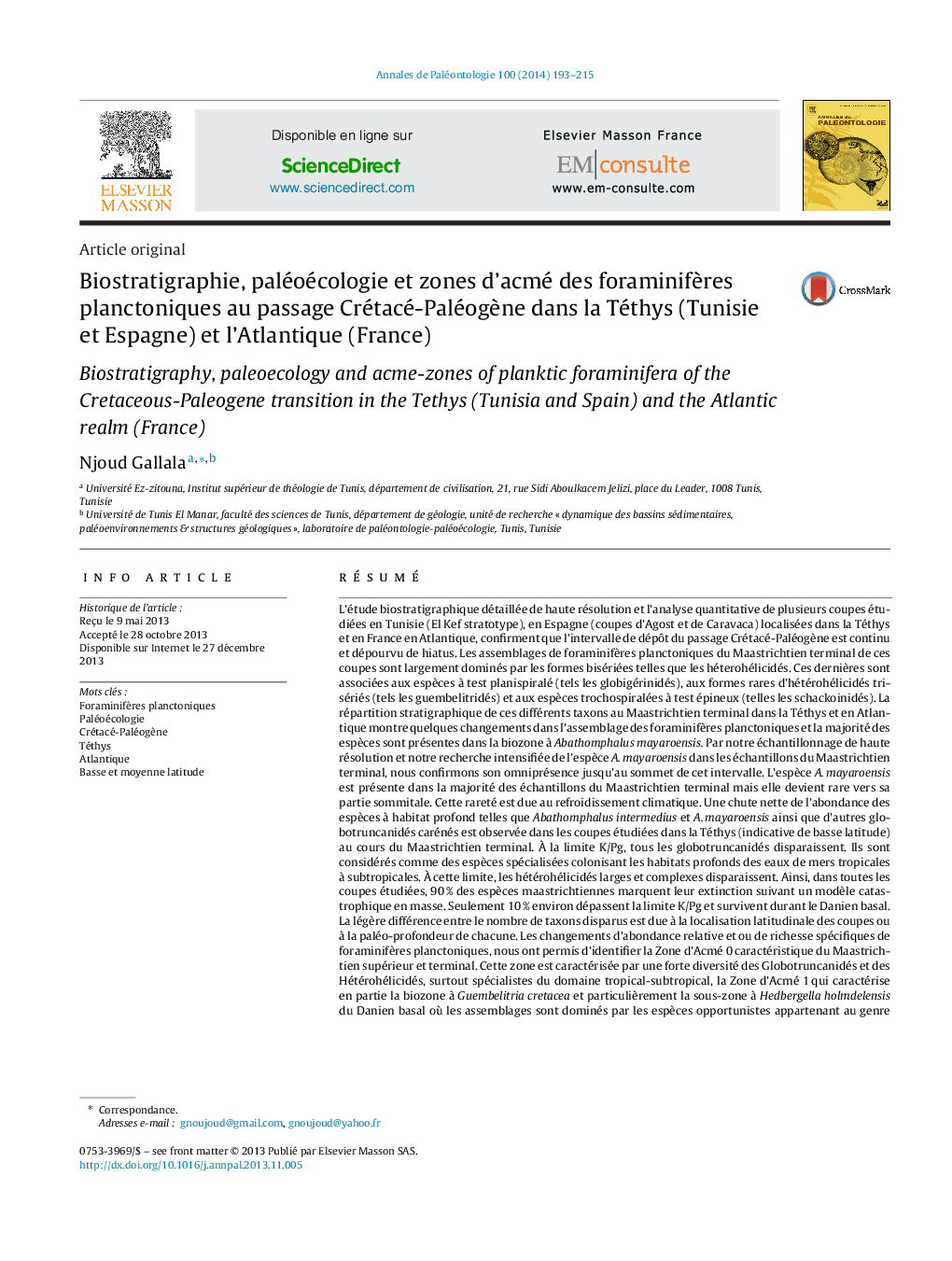| کد مقاله | کد نشریه | سال انتشار | مقاله انگلیسی | نسخه تمام متن |
|---|---|---|---|---|
| 4745358 | 1359705 | 2014 | 23 صفحه PDF | دانلود رایگان |

RésuméL’étude biostratigraphique détaillée de haute résolution et l’analyse quantitative de plusieurs coupes étudiées en Tunisie (El Kef stratotype), en Espagne (coupes d’Agost et de Caravaca) localisées dans la Téthys et en France en Atlantique, confirment que l’intervalle de dépôt du passage Crétacé-Paléogène est continu et dépourvu de hiatus. Les assemblages de foraminifères planctoniques du Maastrichtien terminal de ces coupes sont largement dominés par les formes bisériées telles que les héterohélicidés. Ces dernières sont associées aux espèces à test planispiralé (tels les globigérinidés), aux formes rares d’hétérohélicidés trisériés (tels les guembelitridés) et aux espèces trochospiralées à test épineux (telles les schackoinidés). La répartition stratigraphique de ces différents taxons au Maastrichtien terminal dans la Téthys et en Atlantique montre quelques changements dans l’assemblage des foraminifères planctoniques et la majorité des espèces sont présentes dans la biozone à Abathomphalus mayaroensis. Par notre échantillonnage de haute résolution et notre recherche intensifiée de l’espèce A. mayaroensis dans les échantillons du Maastrichtien terminal, nous confirmons son omniprésence jusqu’au sommet de cet intervalle. L’espèce A. mayaroensis est présente dans la majorité des échantillons du Maastrichtien terminal mais elle devient rare vers sa partie sommitale. Cette rareté est due au refroidissement climatique. Une chute nette de l’abondance des espèces à habitat profond telles que Abathomphalus intermedius et A. mayaroensis ainsi que d’autres globotruncanidés carénés est observée dans les coupes étudiées dans la Téthys (indicative de basse latitude) au cours du Maastrichtien terminal. À la limite K/Pg, tous les globotruncanidés disparaissent. Ils sont considérés comme des espèces spécialisées colonisant les habitats profonds des eaux de mers tropicales à subtropicales. À cette limite, les hétérohélicidés larges et complexes disparaissent. Ainsi, dans toutes les coupes étudiées, 90 % des espèces maastrichtiennes marquent leur extinction suivant un modèle catastrophique en masse. Seulement 10 % environ dépassent la limite K/Pg et survivent durant le Danien basal. La légère différence entre le nombre de taxons disparus est due à la localisation latitudinale des coupes ou à la paléo-profondeur de chacune. Les changements d’abondance relative et ou de richesse spécifiques de foraminifères planctoniques, nous ont permis d’identifier la Zone d’Acmé 0 caractéristique du Maastrichtien supérieur et terminal. Cette zone est caractérisée par une forte diversité des Globotruncanidés et des Hétérohélicidés, surtout spécialistes du domaine tropical-subtropical, la Zone d’Acmé 1 qui caractérise en partie la biozone à Guembelitria cretacea et particulièrement la sous-zone à Hedbergella holmdelensis du Danien basal où les assemblages sont dominés par les espèces opportunistes appartenant au genre Guembelitria, la Zone d’Acmé 2 qui couvre la biozone à Parvularugoglobigerina eugubina caractérisée par les spécimens des genres Palaeoglobigerina et Parvularugoglobigerina et la Zone d’Acmé 3 de la biozone à Parasubbotina pseudobulloides, dominée par les morphotypes bisériés relatifs aux Chiloguembelina et Woodringina.
Biostratigraphical high-resolution analyses and quantitative data confirm that deposition is continuous across the K-Pg transition in several sections in Tunisia (El Kef, stratotype section) and Spain (Agost and Caravaca sections) located in the Tethyan realm and the Bidart sections in the Atlantic realm, without any relevant hiatus. The Upper Maastrichtian assemblages of planktic foraminifera from these sections are largely dominated by small biserial heterohelicids. They are associated to common species having planispiral test (i.e. globigerinelloids), trochospiral test (i.e. hedbergellids, rugoglobigerinids globotruncanids), to rare triserial heterohelicids (i.e. guembelitriids) and trochospiral species showing tubulospines (i.e. schackoinids). Stratigraphical ranges of these diverse taxa through the late Maastrichtian in the Tethyan and Atlantic realms show very few changes in the planktonic foraminiferal assemblages and most of the species are present in the Abathomphalus mayaroensis biozone. By our high-resolution sampling and the intensive research for the A. mayaroensis index species in the uppermost Maastrichtian samples, we confirm that this species is omnipresent up to the top of the Maastrichtian. Therefore, A. mayaroensis is present in almost all samples which are late Maastrichtian in age, but this species became very scarce in the uppermost Maastrichtian samples. This scarceness could be due to a climate cooling. A sharp decrease in relative abundance of the deep dwellers species, like as Abathomphalus intermedius and A. mayaroensis as well as in other keeled globotruncanids is observed at the studied sections from the Tethyan realm (indicative of low latitude) across the latest Maastrichtian. At the K/Pg boundary, all the globotruncanids disappeared. They are considered specialists living in tropical-subtropical deep seawater habitat. At this boundary, large and ornate heterohelicids also disappeared. Therefore, all the studied sections show that about 90 % of the Maastrichtian species became extinct according to a catastrophic mass extinction pattern. Only about 10 % crossed the K/Pg boundary and survived during the earliest Danian. The minor difference in the number of disappeared taxa is related to their latitude location or environment paleodepth. The changes in the species relative abundance, observed in the successive planktic foraminiferal assemblages, make it possible to recognize the Acme-stage 0 typical of the upper Maastrichtian interval. It is characterized by the highest species richness of Globotruncanids and heterohelicids specialists of tropical to subtropical marine conditions, the Acme-stage 1 typical of the Guembelitria cretacea Zone, and in particular of the Hedbergella holmdelensis Subzone dominated by “opportunists” species belonging to Guembelitria, the Acme-stage 2 which corresponds to the Pv. eugubina Zone dominated mainly by specimens belonging to Palaeoglobigerina and Parvularugoglobigerina and the Acme-stage 3 which characterizes mainly the Ps. pseudobulloides Zone dominated by biserial species belonging to Chiloguembelina and Woodringina.
Journal: Annales de Paléontologie - Volume 100, Issue 3, July–September 2014, Pages 193–215